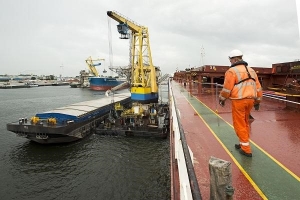


(Posted on 18/09/19)
Transhipment in the North Sea Canal Area of the seaports of Amsterdam, IJmuiden, Beverwijk and Zaanstad rose in the first half of 2019 to 54.1 million tonnes, an increase of 7%. This was the result of an increase in transhipment in the first six months of this year in the port of Amsterdam by 12.3% to 45.4 million tonnes – another record.
In IJmuiden, transhipment fell by 12.3% to 8.5 million tonnes, Beverwijk recorded a 23% increase to 349,000 tonnes and in Zaanstad transhipment fell by 13.2% to 72,000 tonnes.
The increase in Amsterdam in the first half of the year was caused by both liquid and dry bulk and containers. Liquid bulk transhipment rose by 10.6% to 25.9 million tonnes. The 13.8% increase in dry bulk was caused by an increase in the transhipment of coal (23%) and grains (21%) to 17.8 million tonnes. The increase in coal transhipment can be attributed to exports to non-traditional markets. This is not expected to be structural. The increase should also be seen in the context of the sharp fall in recent years. Transhipment in the number of containers also increased by 35%, partly due to Samskip's short sea liner service that the port of Amsterdam focuses on.
These records were also offset by decreases, including in breakbulk (down 20%). There was also a fall in the number of seagoing cruise ships visiting Amsterdam in the first half of the year. In 2019 this was 51, compared to last year’s 74. The introduction of the tourist tax for transit calls on 1 January 2019 led to a number of vessel owners moving to IJmuiden or Rotterdam. The number of river cruise ships that put into Amsterdam in the first half of the year was 1,189, compared to 1,272 a year earlier. This decrease was also caused by the tourist tax. The difference of 83 relates to transit calls. These are cruise ships which, like sea cruises, are subject to tourist tax.
Koen Overtoom, CEO of Port of Amsterdam: ‘After record transhipments in 2018, 2019 has also got off to a very good start. We expect the situation to stabilise in the second half of the year. The increase in coal transhipment has to do with favourable coal pricing conditions. The seasonal build-up of coal stocks later in the year is usually reflected in the transhipment figures. Last year also saw a significant decline in coal transhipment for the German hinterland due to the low water level. Growth in liquid bulk is expected to continue under the current favourable market conditions. We also expect to see further growth in general cargo.’
With this year’s Rail Conference “Rail Freight Transport and Seaports”, a joint initiative... Read more
Asian Bulk Logistics (ABL Group) and ICG have jointly announced the successful completion of ABL&rsquo... Read more
Abu Dhabi based AD Ports Group, a leading global enabler of integrated trade, industry and logistics... Read more
The Executive Board of Hamburger Hafen und Logistik AG (HHLA) has appointed Patrick Krawutschke as Managing... Read more
Abu Dhabi based AD Ports Group, a global enabler of integrated trade, transport, industry, and logistics... Read more
This year marks a significant milestone in maritime innovation as Port Hedland, Australia, celebrates... Read more
Associated British Ports (ABP), the UK’s leading port operator, has announced the latest tranche... Read more
During the Investment, Labour, and Trade Promotion Programme in Japan (November 16–22, 2025),... Read more
AD Ports Group subsidiary Khalifa Economic Zones Abu Dhabi - KEZAD Group, the largest operator of integrated... Read more
Abu Dhabi based AD Ports Group, a global enabler of integrated trade, transport, industry, and logistics... Read more